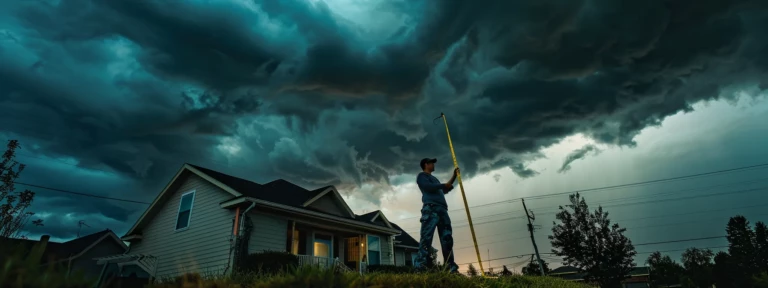Understanding Savannah GA Flood Risks
Understanding Flood Risk in Savannah, GA
As a native of Savannah with personal experience in wading through the complexities of flood zones, I share a common concern with many homeowners here: the rising tides and increased flood risks. Nestled on the Georgia coast, Savannah is no stranger to the whims of the sea level, and the perennial threat of storms adds an ever-present undercurrent of urgency to secure robust flood insurance. For any savvy homeowner, having the right insurance policy is not just a safety net; it’s a staple of coastal living. In this article, you’ll discover the layers of local flood risks and navigate the necessary steps to safeguard your home. Keep reading for an insider’s roadmap to securing the right flood insurance and adapting to Savannah’s unique flood dynamics. Savannah GA flooding explained
Why Savannah, GA Is at High Risk of Flooding
As someone born in Savannah, and having spent countless summers enveloped by its coastal splendor, my familiarity with the local geography runs deep. This city’s charming proximity to the Atlantic, while aesthetically pleasing, is simultaneously the root of a serious hazard: flooding. The rich tapestry of historical data is lined with instances of deluges that have swept through our streets, further exacerbated by a drainage system that often wrestles with the onslaught of water. In my dealings with the Federal Emergency Management Agency, it became crystal clear that Savannah residents face an escalating risk, a trend not helped by the evolving climate change effects that seem to play a capricious game with our local weather patterns.
Geography and Proximity to the Coast
My knowledge of Savannah’s geography has taught me that living in a floodplain comes with inherent risks. The city’s low-lying terrain near the coastline and exposure to the Savannah River naturally predisposes it to frequent flooding, especially during storms and high tides. This geographical characteristic demands a crucial understanding of flood insurance options, including the National Flood Insurance Program, which serves as a safety net for countless homeowners in our community.
With the Atlantic at our doorstep, sea level rise continues to shape the realities of property ownership in Savannah. It is not just about securing home insurance; it’s about recognizing that traditional policies typically do not cover flooding, pushing residents toward additional coverages specifically designed for our unique environmental challenges:
|
Geographic Feature |
Impact on Flood Risk |
Insurance Consideration |
|---|---|---|
|
Proximity to Atlantic Coast |
Heightened risk during storm surges and high tide |
Need for National Flood Insurance Program (NFIP) |
|
Low-lying Floodplain |
Increased likelihood of water inundation |
Requirement for specialized flood coverages |
|
Sea Level Rise |
Long-term escalation in baseline flood risk |
Essential to review policy limits and update regularly |
Historical Flooding Events in Savannah
Savannah’s historical record is punctuated with vast and devastating floods, some of which have struck with little warning, leaving property owners grappling with significant losses. Memories of inundated streets and homes are stark reminders for those holding mortgages, compelling a reevaluation of property insurance to stand resilient against such calamities. The impact of sea level rise and climate change on flood risks in Savannah, GA
The initiation of the flood insurance rate map by FEMA was a pivotal moment for local homeowners. It, unfortunately, coincided with a period marked by intense storms and surges, shedding a glaring light on the demanding need for flood insurance in areas that sear with the heat of coastal Georgia’s climate.
Effects of Climate Change on Local Weather Patterns
My personal experiences and expertise in Savannah have underscored the dramatic ways in which climate change is reshaping our expectations and experiences regarding weather. As patterns become more erratic and storm severity escalates, emergency management officials in Georgia emphasize the pressing need for effective flood insurance policies. These policies are vital shields against the financial havoc wrought by natural disasters, increasingly fueled by a volatile climate.
Upgraded stormwater systems in Savannah have become a critical focus in the larger conversation about infrastructure resilience. Yet, as a flood insurance advisor, I’ve observed that no amount of engineering can fully negate the necessity of robust insurance policies. The unpredictable intensity of rainfalls and the escalating number of flood events serve as a firm reminder: vigilance in updating and maintaining flood insurance is essential for every home and business owner in the face of a shifting climate landscape.
|
Climate Factor |
Impact on Savannah, GA |
Homeowner Response |
|---|---|---|
|
Intensified Storms |
More frequent and severe flood events |
Review and strengthen flood insurance coverage |
|
Erratic Weather Patterns |
Less predictability in flood risk management |
Engagement with emergency management for preparedness |
|
Rising Sea Levels |
Chronic coastal inundation |
Support updates to stormwater systems and policies |
How to Assess Your Property’s Flood Risk in Savannah
Measuring the flood risk for your Savannah home necessitates a clear understanding of the local flood zones, which categorize various areas based on exposure to water hazards, from rain to tide. Being well-versed in these designations, equipped with resources and tools for flood risk assessment, empowers you with valuable information to protect your property. Consider this: an Elevation Certificate can make a significant difference, providing a detailed snapshot of your home’s altitude relative to the expected flood levels—a critical piece in the broader puzzle of climate resilience and flood management. In the quest to safeguard your residence, accurate knowledge of elevation and flood zones is an indispensable ally.
Understanding Flood Zones in Savannah
Understanding Savannah’s flood zones begins with recognizing the interplay between our river systems and the ocean’s influence. River flooding, compounded by the threat of storm surge during hurricanes, delineates certain zones where homes and businesses are more susceptible to coastal flooding. Awareness of these zones is critical for assessing risk, and for me, this has meant advising residents to keenly observe these delineations when purchasing properties or reviewing their current insurance policies.
Elevation is the defining factor in flood zone designation; it determines a property’s potential to withstand both riverine and coastal flooding. In my professional conversations, I routinely stress the importance of having an accurate elevation certificate. It guides Savannah homeowners in grasping their proximity to the coast and understanding the implications of their property’s placement relative to the estimated flood heights, directly affecting insurance requirements and premiums.
Tools and Resources for Flood Risk Assessment
Navigating the terrain of flood risk in Savannah requires a robust set of tools and resources, particularly for properties located in areas identified as a special flood hazard area. One such vital resource is the ‘Flood Map Service Center’ operated by FEMA, where homeowners can access up-to-date flood maps. Understanding these maps could be the difference between a well-prepared property and a costly surprise come hurricane season, when wind and water combine with devastating force.
For Savannah residents, keeping up with real-time data is essential, especially when a flood warning is issued. The integration of local flood gauges and online tools, such as those provided by the National Weather Service, equips homeowners with timely information to enact plans rooted in climate resilience. Agile response to emerging alerts forms a bulwark against the encroachment of floodwaters exacerbated by climate change.
|
Resource |
Purpose |
Impact on Homeowners |
|---|---|---|
|
FEMA’s Flood Map Service Center |
Identify property flood zones |
Improved understanding of flood risk and insurance needs |
|
Local Flood Gauges |
Monitor water levels in real-time |
Early detection and preparation for flooding events |
|
National Weather Service Alerts |
Receive flood warnings |
Immediate actions to safeguard property and lives |
Importance of an Elevation Certificate for Your Property
Securing an Elevation Certificate is a strategic move, drafted by an engineer, that offers carefully measured data crucial for homeowners like us in Savannah. Amidst the lapping tides of the Atlantic Ocean and dense marsh areas, this document becomes the law of the land, setting the exact height of structures above potential floodwaters and impacting insurance rates significantly.
The importance of the Elevation Certificate in our city cannot be overstated. It embodies a data-driven approach to comprehending how close our homes stand in relation to the increasingly restless Atlantic, offering a key piece of evidence when it comes to complying with local building codes and floodplain management laws.
Navigating Savannah’s Flood Zone Map
Stepping into the realm of Savannah’s flood zone map unlocks vital insights for every homeowner and prospective buyer. My challenge with these maps began years ago when I first grappled with the intricate differences between A, AE, and VE flood zones—each bearing distinct implications for construction, existing structures, and insurance. As a kid spending time around the canals and waterways, I never imagined those carefree waves would become such central elements in determining loan terms or insurance premiums. Armed with the right knowledge, locating your property on the flood zone map can be more than a routine check; it’s a crucial step in understanding how your investment is impacted by the flood risks associated with Savannah’s unique topography. It’s not just an faq for insurers; it’s the key to safeguarding the value and safety of your home against nature’s unpredictable tides.
Differences Between A, AE, and VE Flood Zones
Savannah’s map labels regions as A, AE, or VE zones, each bearing different repercussions for flood defense and insurance. The ‘A’ zones signify an area with a 1% annual chance of flooding, often leading to less severe flood damage compared to AE zones, which are mapped by detailed studies from the National Oceanic and Atmospheric Administration. Properties in these areas require careful consideration when developing buildings to minimize the crippling effects of flood waters.
The designation ‘VE’ implies the highest risk, prominently coastal regions where extreme weather can bring about violent wave action on top of standard flooding. In these zones, buildings face a greater fury from the sea and therefore must comply with more rigorous structural requirements. Adhering to these elevated standards is a key factor in safeguarding Savannah homes from the devastating impact of flood waters fueled by powerful storms.
How to Find Your Property on the Flood Zone Map
Locating your property on Savannah’s flood zone map is paramount for any comprehensive risk assessment including those prompted by concerns over wildfire, dam breaches, and erosion. By entering your address into the appropriate search field on FEMA’s Flood Map Service Center, you can pull up detailed visuals that shed light on how your real estate may be affected by these factors. This step is crucial, as it also helps to identify the specific regulations and insurance requirements for your property’s zone.
Amidst the swirl of news stories about unpredictable weather events, I always tell my peers in Savannah to use the flood zone map as an early gauge of potential exposure, not just to flooding, but to related risks such as erosion, which can weaken foundations and undermine the stability of structures near waterways. As a savvy homeowner or real estate investor, using the map for a meticulous assessment equips you with knowledge to better protect your property and proactively manage your flood insurance needs.
Implications of Flood Zones on Insurance and Property Value
As a long-term Georgia resident and flood insurance expert, I’ve learned that Savannah’s designation as a barrier island substantially influences flood insurance rates and property values. The location of a house—whether it’s on the first floor or has a basement, along with the quality of local infrastructure—plays a critical role in a home’s vulnerability assessment, which insurers review diligently to determine premiums.
Engaging with the unique challenges Savannah poses demands that homeowners stay vigilant about how regional flood zones may affect long-term investment value. When a property is saddled within a high-risk zone, not only does this increase insurance costs, but it can also make the ground floor—or any level—more difficult to insure, potentially dampening overall value in the marketplace.
The Role of Savannah’s Topography in Flood Risk
My experience in the flood insurance industry has given me a firsthand look at how the topography of Savannah directly affects flood risk for homeowners. The city’s landscape, predominantly low and level, has no mercy when it comes to flooding, as drainage systems can struggle to keep pace with the onslaught of water. The Savannah River, along with numerous tidal creeks, serve as arteries for rising waters, particularly when influenced by the frequency of coastal storms. These bodies of water, once pathways for commerce, have shaped our flood mitigation practices as well. While coordinating efforts to secure the safety of our homes, I’ve often turned to resources like NOAA Weather Radio to stay abreast of any changes in conditions, and diligently reviewed PDF documents outlining our city’s historical response to these natural events. Despite our best efforts, the persistent challenge posed by our surroundings calls for continuous vigilance and improvement in our approach to managing flood risk.
Low-Lying Areas Most Susceptible to Flooding
As a Savannah local, I can attest that our low-lying neighborhoods near the ocean are particularly vulnerable to flooding. Georgia Residents like myself often consider retrofitting as a viable option to elevate homes above projected flood levels, thus minimizing potential damage and positively impacting our community rating system.
In response to the persistent flood risk, I’ve seen an increasing number of homeowners in these susceptible areas maintain a NOAA weather radio as a lifeline, alerting us to imminent weather threats. Our collective awareness contributes to a broader understanding of protecting both our habitat and our homes from the whims of nature.
Impact of Tidal Rivers and Creeks on Flood Risk
My years invested in understanding flood resilience have highlighted Savannah’s complex network of tidal rivers and creeks as pivotal in local flood scenarios. Just as the world wide web binds together information, these waterways interlace to create a matrix that, under the pressure of storm conditions, can overflow and breach the city’s natural and man-made defenses, including essential ditches designed for drainage.
In the wake of events like Hurricane Harvey, my engagement with the University of Georgia’s environmental research has deepened my appreciation for the extent to which these tidal systems can amplify local flood risks. Their fluctuating levels, influenced by tidal forces and torrential rains, present an ongoing challenge to Savannah’s flood management strategies, underscoring the need for continuous adaptation and fortified resilience measures.
Savannah’s Historical Mitigation Efforts
Throughout my time in Savannah, I have observed the methodical ways in which our city has tackled the endemic issue of flooding. With an investment in the science of hydrology, Savannah has refined its infrastructure, amending building codes and zoning laws to reduce flood impact. Emphasizing lower deductible options for flood insurance policies has also been a way to encourage more homeowners to take precautionary measures against disaster.
Additionally, strategic changes to the way properties handle potential flood events have involved setting up escrow accounts specifically for disaster relief and recovery. Recognizing the financial burden that sudden calamities can impose on homeowners, Savannah’s community planners have increasingly recommended this practice, underscoring their commitment to ensuring that residents can bounce back from flood-related losses.
Essential Steps to Prepare for a Flood in Savannah
As the seasons shift and the potential for fierce weather looms over Savannah, GA, it is paramount for each homeowner to establish a robust plan that can stand up to the nature’s ravaging moods. Crafting a comprehensive emergency plan involves more than just a to-do list; it’s a refined methodology fostering safety and preparedness within the framework of esoteric local flooding patterns. Not just fire and storm; in Savannah, water is equally a force that demands respect and readiness. Integrating sandbags and other barriers as fortifications for your property is a critical preemptive strike against the relentless surge of floodwaters. To stay abreast of imminent threats, I always advise keeping a battery-powered radio on hand and bookmarking relevant web pages, ensuring that key contacts and information sources for flood warnings are at the ready. As we navigate the complexities of flood risks, alertness to tax-funded emergency services and accessible, accurate communication channels becomes our compass in the storm, guiding us towards safety.
Creating a Comprehensive Emergency Plan
In my years of learning the importance of flood preparedness, I’ve understood that comprehensive emergency plans are essential tools in urban planning, particularly for coastal cities like Savannah. Despite our distance from the Mississippi’s notorious floodplain, the lessons learned there have reinforced the need for robust strategies. In creating these plans, my focus has been on identifying and reducing vulnerability by integrating knowledge of local water systems, including the subtleties of the Ogeechee River’s flood dynamics.
Devising an emergency plan must be more than a generic template; each needs to account for Savannah’s unique floodscape. I’ve worked closely with local urban planners to develop a tool that not only prepares my fellow residents for immediate action but also ingrains a lasting resilience mindset. This plan is continually refined through real-world scenarios and proactive adjustments to factor in the unpredictable nature of coastal flooding, thus reducing our community’s vulnerability in the long term.
Protecting Your Property With Sandbags and Other Barriers
When tidal flooding threatens, employing sandbags becomes a cornerstone of emergency preparedness. Strategically placed, these barriers can divert water away from your home, enhancing your overall risk management protocol.
The effective use of sandbags, though labor-intensive, can significantly mitigate potential damage, thereby controlling repair costs. It’s crucial to document this preparation method within your flood plan, serving as a tangible step toward safeguarding your investment.
|
Preparation Method |
Function |
Impact |
|---|---|---|
|
Sandbags and Barriers |
Divert floodwaters |
Enhance risk management, reduce repair costs |
Key Contacts and Information Sources for Flood Warnings
In my role as a flood insurance advisor, I stress the importance of staying connected with local authorities who oversee flood warnings and updates within our jurisdiction. Savannah’s unique topography, where forest meets marshland that succumbs to the advance of seawater, mandates that we pay close attention to the guidance from these experts. Their insights are crucial, especially as urban developments have increased the “urban heat island” effect, making our climate responses all the more critical.
Reliable information sources continue to be essential for understanding flood risk. Beyond the educational PDFs and community meetings, subscribing to alerts from the National Weather Service and local emergency management offices provides timely warnings about imminent dangers. These warnings, related to rising waters or other weather abnormalities influenced by Savannah’s topography and proximity to water, can make the difference in how effectively we protect our homes and community.
How Climate Change Intensifies Flood Risk in Savannah
As a product of my Savannah roots, I have watched the Atlantic nibble steadily at our shores, causing sea levels to climb and posing a grave challenge to both finance and market value of coastal properties. This insidious rise promises to alter flooding frequency, signaling urgent revisions in coastal management strategies. The changes in rainfall patterns and intensity that I’ve observed are reshaping our historic soil composition, with now irrefutable consequences for localized flooding. Such shifts compel us to consider adaptive measures that are poised to define our community’s future flood risks and resilience. Balancing proactive flood defenses with the economic facets of living in a growing, yet vulnerable, coastal city is now an unwavering part of our everyday life in Savannah.
Sea Level Rise and Its Impact on Flooding Frequency
Observing the transformation of Savannah’s coastline over the years, it’s undeniable that the gradual swell of the Atlantic has brought about a higher base level for potential floodwaters. The rising sea level, accelerated by the thawing of polar ice, multiplies the risk of flooding, especially during high tide and extreme weather events.
The increased frequency at which Savannah contends with flooding not only threatens our historical landmarks but also strains our infrastructure, demanding an escalated response from city planning and disaster preparedness initiatives:
|
Factor |
Description |
Implications for Savannah |
|---|---|---|
|
Sea Level Rise |
Heightened base level of oceans due to melting ice caps |
More common and severe floods, particularly at high tide and during storms |
|
High Tide |
Natural increase in sea level during cycles of the moon |
Enhanced risk of flooding in coastal and low-lying areas |
|
Extreme Weather |
Increasing intensity and frequency of storms as climate change progresses |
Higher likelihood of devastating storm surges leading to significant floods |
Our city’s resilience is tested as waters encroach areas not previously affected by flooding, highlighting the need for updated flood mapping and community engagement to mitigate future risks. As residents, we’re urged to revise our understanding of flood insurance coverage and remain proactive about climate change’s role in amplifying potential hazards.
Changes in Rainfall Patterns and Intensity
My time in Savannah has led to an intimate understanding of the patterns of precipitation that bathe our cobblestone streets and drench our verdant squares. The shifting climate has altered the rhythm of rainfall, not just in volume but in the velocity at which the skies unload, transforming gentle showers into sudden, torrential downpours that test our water management systems.
These variations in rainfall significantly stress the capacity of our city’s infrastructure, designed for a bygone era’s weather patterns. Now, the cloudbursts overwhelm drains and gutters more frequently, necessitating a forward-thinking approach to urban planning and flood risk insurance that takes into account these emerging, unpredictable patterns.
Adaptive Measures for Future Flood Risks
In response to Savannah’s flood risk, tailored and strategic city planning is essential. Advocacy for green infrastructure, such as the creation of urban wetlands and restoration of native vegetation, can serve as natural sponges, mitigating the extent of flood damage while enhancing the city’s beauty and ecological health.
As a seasoned flood insurance advisor, I also recognize the significance of community-wide education initiatives. These programs should aim to inform homeowners about individual flood defenses like installing sump pumps, applying sealants, and adopting water-resistant building materials, thereby equipping each property with an added layer of security against flooding’s calamitous grip.
Understanding FEMA Flood Maps for Savannah
As we delve into the world of flood risk in Savannah, a primary resource at our disposal is the collection of FEMA flood maps. These maps undergo a rigorous development process, where topographical data, historical flood records, and hydrological models blend to yield a tool that’s at the forefront of urban planning and insurance considerations. Understanding how to navigate these maps is essential for homeowners, giving clarity to the risk profile of their properties. However, it’s not without its complexities. Periodic updates reflect the evolving landscape and risk, but can also introduce challenges when discrepancies arise between real-world conditions and the map’s depiction. Acknowledging the limitations of these maps is as crucial as leveraging their insights, for they play a pivotal role in decision-making—from mitigation strategies to insurance purchases.
The Process of Map Creation and Updates
Creating the FEMA flood maps is an intricate process, informed by a combination of hydrologic and hydraulic studies coupled with topographical data specific to Savannah. These studies meticulously analyze the expected floodplain boundaries, providing a vital service to architects, developers, and insurers alike.
Since the natural and built environment is not static, the flood maps are revised and updated periodically to reflect changes such as alterations in land development, erosion patterns, and, crucially, the effects of climate change. These updates ensure that flood maps remain an accurate reflection of current risks, aiding in making informed decisions about property and insurance.
How to Interpret FEMA Flood Maps
Interpreting FEMA flood maps starts with recognizing the significance of each zone and what it suggests about flood risk. My years navigating these maps have taught me to pay close attention to zone designations such as A, AE, and VE, which communicate a property’s flood risk based on historical and environmental data—details decisive for appropriate flood insurance coverage.
Deciphering these maps also requires understanding the relevance of Base Flood Elevations (BFEs) indicated on them. As a Savannah homeowner, assessing your property’s elevation in relation to these BFEs can inform you of the likelihood of flood occurrences and help determine the requisite insurance to combat potential financial repercussions from flood damage.
Challenges and Limitations of Current Maps
While FEMA flood maps offer critical insight into potential hazards, they’re not always in sync with the dynamic nature of Savannah’s landscape. The inherent lag between environmental changes and map revisions can sometimes leave homeowners with an outdated understanding of their flood risks, making vigilant, personal observation and supplementary research indispensable.
Another challenge when navigating FEMA’s maps lies in their complexity, which can be daunting for homeowners unfamiliar with interpreting technical data. In my consultations, I stress the importance of enlisting the help of professionals when dissecting these maps to ensure accurate risk assessment and secure the appropriate level of insurance protection. For more information, you may refer to this detailed article on understanding flood zone A and FEMA flood maps.
Mitigation Strategies to Reduce Flood Damage in Savannah
In my years of engaging with Savannah’s flood risks and helping homeowners navigate the complexities of flood insurance, I’ve become well-acquainted with the range of mitigation strategies at our disposal. Local government initiatives often focus on grand-scale projects like the construction of sea walls and flood barriers, which create a physical shield against incoming waters. On a more strategic level, land use planning and regulations provide a blueprint for orderly growth while minimizing potential flood damage by dictating where and how structures are built. Equally compelling is the role of natural solutions, such as wetland restoration, which not only buffer against storm surges but also enhance biodiversity and water quality. Each of these approaches, from the engineered to the ecological, plays its part in a multifaceted defense system designed to stave off the ever-present threat of flooding to our historic city.
Government and Community Level Flood Barrier Projects
In Savannah, we’ve seen significant advancements in flood mitigation due to collaborative government and community efforts focused on barrier projects. The city has fortified its stance against rising waters by constructing sea walls and leveraging existing natural features like dunes to serve as barriers, a testament to strategic and preventive urban planning.
Community-level initiatives have also made substantial contributions by advocating for and implementing temporary flood defense systems, such as deployable flood gates, during periods of imminent threat. These projects exemplify the power of local engagement and the importance of being proactive, rather than reactive, in the face of natural disasters.
Land Use Planning and Regulations to Manage Flood Risk
Meticulous land use planning and adherence to stringent building regulations are central to managing the flood risk in Savannah. Balancing development ambitions with environmental constraints, these regulations dictate where and how high buildings must be constructed, thereby safeguarding lives and reducing the potential financial burden resulting from flood damage.
My consultations with homeowners reinforce the notion that respecting these land use directives not only preserves the integrity of Savannah’s unique landscape but also serves as a long-term investment in property safety. As a specialist in flood insurance, I’ve witnessed how these proactive measures can translate into lower insurance premiums and increased property values, demonstrating the tangible benefits of regulatory compliance.
Benefits of Natural Solutions Like Wetland Restoration
Embracing the restoration of wetlands has proven to be an exceptionally effective natural defense against the risk of flooding in Savannah. These areas act like sponges, absorbing excess water and reducing the speed at which runoff enters our rivers and streams.
The strategic reestablishment of native wetlands not only bolsters our defenses against rising waters but also provides ancillary benefits to wildlife by recreating lost habitats. The dual purpose of wetland restoration underscores its value as a key component in our city’s comprehensive flood mitigation portfolio:
|
Restoration Effort |
Flood Mitigation Impact |
Environmental Benefit |
|---|---|---|
|
Wetland Restoration |
Increases water absorption capacity |
Rehabilitates natural habitats and supports biodiversity |
Insurance Options for Flood Protection in Savannah
Navigating the waters of flood insurance in Savannah, while complex, is a necessary step toward protecting what is often your biggest investment—your home. Among these protective measures, FEMA’s National Flood Insurance Program (NFIP) stands as a familiar beacon for many homeowners, providing baseline coverage and peace of mind. However, an understanding that one size doesn’t fit all leads us to explore the realm of private flood insurance alternatives, offering tailored solutions that might better suit individual needs. Beyond the structural fortitude of our dwellings, securing adequate coverage for possessions within—the contents—completes the circle of comprehensive protection. This layered approach ensures that, come high water, both your home and the memories it houses are shielded from the financial storms that follow.
Understanding FEMA’s National Flood Insurance Program (NFIP)
Having encountered the nuances of securing flood coverage for my Savannah home, I recognize that FEMA’s National Flood Insurance Program (NFIP) is a foundational layer of protection for homeowners. The NFIP offers coverage for both the structure of the home and its contents, providing a safety net against flood-related damages not typically covered by standard homeowners insurance policies.
My journey into the realm of flood insurance has shown me that the NFIP also encourages communities to adopt and enforce floodplain management regulations, which can lead to reduced policy premiums. Engaging with this federal program has taught me the value of understanding its intricacies and limitations, ensuring that as a resident, I am aptly prepared for Savannah’s flood risks:
|
Component |
NFIP Role |
Benefit to Savannah Homeowners |
|---|---|---|
|
Structure Coverage |
Provides financial protection for the physical home |
Secures the dwelling against flood damage |
|
Contents Coverage |
Covers personal possessions within the home |
Ensures personal property is financially safeguarded |
|
Floodplain Management |
Promotes safer community development practices |
Leads to lower insurance premiums through compliance |
Comparing Private Flood Insurance Alternatives
In my professional experience, private flood insurance can sometimes offer more flexible coverage options compared to the NFIP, especially for those residing in high-risk flood areas like Savannah. These policies may feature higher coverage limits or lower deductibles, aligning with personal risk assessments and asset values which could be more accurately reflective of the unique flood risks we face along our stretch of the Georgia coast. It can even provide excess flood insurance coverage on top of the federal flood insurance program.
An exploration into the world of private flood insurance also reveals the potential for customized coverage that caters specifically to individual properties and homeowner circumstances. They often provide additional living expenses if a home becomes uninhabitable due to flooding, an option that can be vital during the rebuilding phase:
|
Policy Feature |
NFIP |
Private Insurance |
|---|---|---|
|
Coverage Limits |
Set maximums |
Higher potential limits |
|
Deductibles |
Standard options |
Possibility for lower deductibles |
|
Additional Living Expenses |
Not typically covered |
Often included |
Importance of Coverage for Both Building and Contents
As I navigate the insurance landscape for my fellow Savannah residents, I stress the indisputable value of having comprehensive coverage for both the structure of the home and its contents. Ensuring the physical edifice of your residence is protected underlines the importance of rebuilding and repairs following a flood, while insuring contents safeguards your personal belongings, which often bear both financial and sentimental value.
In the wake of a catastrophic flood, the absence of full coverage can leave one stranded amidst financial ruin and personal upheaval. My advice is steadfast: carefully assess insurance plans that encompass the sanctity of your home’s infrastructure as well as the treasures within, fostering a holistic approach to security and recovery in Savannah’s flood-prone areas.
Future Projections of Flood Risk in Savannah, GA
Peering into Savannah’s future, understanding the nuances of flood risk becomes imperative. With predictions pointing toward more frequent and intense flooding, we must pivot towards comprehensive strategies that bolster our city’s resilience. This involves not only adaptive planning and construction but also a concerted effort in community-based education. Enabling homeowners and businesses to adapt and prepare for the realities of a changing environment is crucial. Such engagement forms the bedrock of a proactive culture, critical in the face of encroaching waters that may redefine the very character of our beloved, historical city.
Predicted Changes in Flood Patterns and Severity
With climate models indicating an upward trend in sea level and storm intensity, Savannah, GA, is expected to experience more frequent and severe flooding in the coming decades. The confluence of coastal surge and heavy rainfall could redefine current flood zones, pushing the thresholds of existing flood defenses and challenging the adequacy of our infrastructure.
These changes prompt not only a reassessment of risk on paper but demand tangible adjustments to our living environment. Predictive data underscores the urgency to innovate our approach to urban development and individual property protection in response to these looming shifts:
|
Risk Factor |
Expected Change |
Impact on Savannah |
|---|---|---|
|
Sea Level Rise |
Continued increase |
Expansion of flood-prone areas |
|
Storm Frequency |
Growth in occurrence |
Greater stress on flood mitigation systems |
|
Storm Intensity |
Elevation in severity |
Escalated potential for catastrophic damage |
Planning and Building for Resilience Against Future Floods
My years in the thick of Savannah’s flooding challenges have reinforced the value of resilient building designs. Incorporating elevated foundations, backflow prevention valves, and thoughtful landscape architecture can significantly dampen the harsh effects of floodwaters, keeping structures both intact and insurable as we look toward an uncertain climatic future.
Participating in Savannah’s community efforts, I’ve advocated for the inclusion of flood resilience features in local building ordinances. Continuous conversations with architects and city planners have led to creating spaces that harmonize with our flood-prone environment, ensuring new constructions are not only aesthetically in sync with our historical tapestry but also capable of withstanding the rising tide of changes forecasted for our region.
Community Engagement and Education on Flood Preparedness
Engagement at a community level is a cornerstone of flood preparedness in Savannah, underscoring the need to educate residents on the risks and appropriate responses to flooding. As part of this commitment, I regularly conduct workshops and discussions, bringing the essence of flood awareness to doorsteps, schools, and local assemblies where understanding can take root and grow into a culture of preparedness.
My personal investment in Savannah extends to fostering a network of informed locals, equipped not only with the knowledge to handle floods but also with the communicative tools to disseminate critical information swiftly. Through collaborative relationships with emergency services, we’ve developed a streamlined process to ensure that when the waters rise, every member of our community is ready to respond with efficiency and confidence.
Conclusion
Understanding flood risk in Savannah, Georgia is critical for homeowners due to the city’s low-lying geography and proximity to the Atlantic coast, which increase vulnerability to flooding. Accurate knowledge of flood zones and possession of an Elevation Certificate are indispensable in assessing risk and securing the right flood insurance. Residents must engage with both federal programs like the NFIP and explore private insurance options to ensure comprehensive coverage of their property and belongings. As climate change intensifies flood frequency and severity, proactive community engagement and adaptive measures are essential to safeguard Savannah’s future against these rising threats.
Information contained on this page is provided by an independent third-party content provider. This website make no warranties or representations in connection therewith. If you are affiliated with this page and would like it removed please contact editor @producerpress.com







